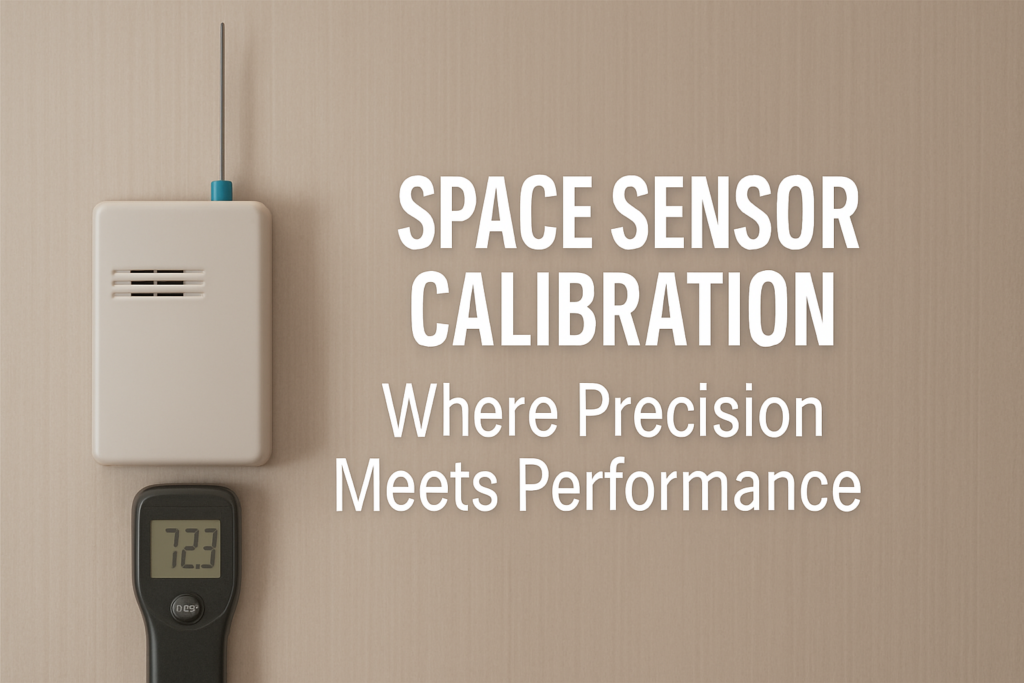In the world of modern facilities management, where energy efficiency, occupant comfort, and operational excellence are inseparable, one technical discipline often stands quietly at the core: space sensor calibration. Though it may appear routine, calibrating temperature, humidity, and air quality sensors is a critical technique that bridges theoretical knowledge with real-world application, and it is here that human expertise and technology must work hand in hand.
Why Calibration Matters: Theory Meets Reality
At its essence, calibration ensures that the data our Building Automation Systems (BAS) use to make decisions is trustworthy. According to ASHRAE Guideline 1.1 and Standard 111, regular calibration is a non-negotiable requirement. A sensor reading even 2°F off can cause HVAC systems to overheat or overcool a space, resulting in energy cost increases of up to 10%, as emphasized by Smart Buildings Academy.
However, beyond numbers and standards lies a deeper reality: a miscalibrated sensor doesn’t just waste dollars—it erodes occupant trust, compromises comfort, and degrades system efficiency over time.
Consider a real-world scenario:
In a university facility with constant-volume air handling units (AHUs) serving lecture halls, a faulty sensor drifted 3°F above the actual room temperature. Students consistently complained of stifling conditions. Despite the BAS operating in “occupied mode” at 72°F, the exact temperatures climbed to 75°F without being noticed.
It wasn’t until a comprehensive sensor calibration sweep was conducted that the root cause was found. By recalibrating space sensors to achieve an accuracy of ±0.5°F, complaints decreased by 80%, energy consumption was normalized, and occupant satisfaction soared.
Lesson learned: Even sophisticated automation cannot compensate for poor inputs. Data quality is everything.
The Calibration Process: Where Expertise Shines
While some calibration is automated through BAS tools, effective calibration remains a largely human-driven process. Here’s how we, as facility professionals, combine our expertise with available technology:
1. Preparation: Understanding Sensor Behavior
Before touching a sensor, we review historical trend logs through the Building Automation System (BAS). We ask:
- Has the sensor reading drifted slowly or sharply?
- Are there patterns linked to time of day, occupancy, or sun exposure?
- Are multiple complaints concentrated in the same area?
This investigative mindset prevents chasing symptoms and leads us to systemic solutions.
2. Physical Inspection: Confirm Installation Conditions
A space sensor installed behind bookshelves, near exterior doors, or under supply vents cannot provide representative readings. We inspect sensor placement relative to:
- Airflow
- Heat sources
- Solar radiation
- Physical damage
Real-world example:
At a corporate office, a sensor hidden behind a decorative wall panel read 5°F cooler than the room’s actual conditions, leading to years of unnecessary heating in winter. Relocating and recalibrating it saved the building thousands in operational costs annually.
3. Comparative Measurement: The Golden Reference
We deploy calibrated reference thermometers (ideally NIST-certified) at the occupant level, allowing the sensor and reference to stabilize side by side for at least 5–10 minutes. Then:
- If deviation exceeds the manufacturer’s tolerance (typically ±0.5°F), we adjust the offset at the BAS controller level.
- We record “before” and “after” data for documentation and trend analysis.
This careful comparison—technology combined with human validation—ensures that we trust the sensor’s voice in the larger building orchestration.
4. BAS Integration: Fine-Tuning for System Harmony
After calibration, we don’t stop.
We observe BAS-controlled responses:
- Does the VAV box modulate properly?
- Does the reheat coil operate efficiently?
- Does the AHU maintain zone temperature without cycling excessively?
Our expertise enables us to view the building as a living system, not just its components. Minor sensor inaccuracies, left unchecked, ripple outward, causing energy waste and mechanical wear.
Deeper Understanding: The Multiplier Effect
When we engage deeply with sensor calibration—not as a task to check off but as a critical, knowledge-driven responsibility—we unlock a cascade of benefits:
| Dimension | Impact |
| Energy Efficiency | 5–15% reduction in HVAC energy use |
| Equipment Longevity | Fewer short cycling and premature failures |
| Occupant Comfort | Fewer hot/cold complaints; stable environments |
| Operational Insight | BAS optimization with trustworthy data |
| Sustainability Goals | Progress toward green building certifications |
At the heart of this success is our human expertise: the ability to interpret data, investigate anomalies, apply standards, and exercise sound judgment.
Technology and Human Expertise: A Unified Force
Today’s smart BAS platforms offer sensor auto-calibration, self-learning setpoint adjustments, and AI-driven fault detection. Yet none of these technologies diminish our role—they amplify it.
It is our partnership with technology—our vigilance, discernment, and proactive mindset—that enables facilities to function at their peak.
We, the stewards of building health, must remain committed to ongoing learning, critical thinking, and collaboration across teams.
Sensor calibration is no longer just a technical procedure—it is a leadership discipline.
Final Reflection: Are We Truly Dialed In?
As Smart Buildings Academy challenges us to ask: When was the last time our BAS was truly dialed in?
Let’s answer with pride through methodical calibration, careful observation, and an unwavering commitment to excellence. Because when we harmonize technology with human expertise, our buildings don’t just operate—they thrive.



